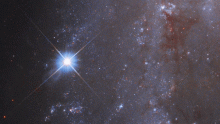Big Fireworks [1]
Many New Year’s Eve celebrations include big displays of fireworks. Thanks to COVID-19, many of this year’s celebrations have been cancelled or scaled back. If our eyes were tuned to different wavelengths of light, though, we’d see big fireworks in the sky every night.
Some fireworks are at wavelengths that the human eye can perceive, but they’re just too faint to see. They include the exploding stars known as supernovae. Several of them pop off every day. And each one can outshine an entire galaxy of normal stars. None has exploded in our galaxy in four centuries. Those in other galaxies are so far away that you almost always need a telescope to see them.
And in fact, we don’t want a supernova to be too bright. An especially close one could cause big problems. We’ll have more about that tomorrow.
About once a day, orbiting satellites detect gamma-ray bursts. They’re extremely powerful explosions that “beam” gamma rays in our direction. Many of them are so bright that they’d be visible if our eyes could tune in to gamma rays.
The same thing applies to fast radio bursts. These outbursts last just a fraction of a second, but they can be extremely bright. So far, astronomers haven’t figured out their cause. They could be powered by collisions between the heavy cores of dead stars, but no one knows for sure.
So the universe produces dramatic fireworks — every night of the year.
Script by Damond Benningfield
Keywords:
- Gamma-Ray Bursts [3]
- Supernova [4]


